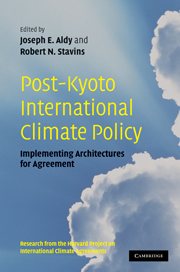Book contents
- Frontmatter
- Contents
- Harvard Environmental Economics Program, International Advisory Board
- Harvard Project on International Climate Agreements, Faculty Steering Committee
- Harvard Project on International Climate Agreements, Project Management
- List of figures
- List of tables
- List of contributors
- Foreword
- 1 Introduction
- Part I Alternative international policy architectures
- 2 An elaborated proposal for a global climate policy architecture: specific formulas and emission targets for all countries in all decades
- 3 The EU emission trading scheme: a prototype global system?
- 4 Linkage of tradable permit systems in international climate policy architecture
- 5 The case for charges on greenhouse gas emissions
- 6 Towards a global compact for managing climate change
- 7 Sectoral approaches to a post-Kyoto international climate policy framework
- 8 A portfolio system of climate treaties
- Part II Negotiation, assessment, and compliance
- Part III The role and means of technology transfer
- Part IV Global climate policy and international trade
- Part V Economic development, adaptation, and deforestation
- Part VI Modeling impacts of alternative allocations of responsibility
- Part VII Synthesis and conclusion
- Appendix A Selected List of Individuals Consulted, Harvard Project on International Climate Agreements
- Appendix B Workshops and Conferences, Harvard Project on International Climate Agreements
- Glossary and Abbreviations
- Index
2 - An elaborated proposal for a global climate policy architecture: specific formulas and emission targets for all countries in all decades
Published online by Cambridge University Press: 05 June 2012
- Frontmatter
- Contents
- Harvard Environmental Economics Program, International Advisory Board
- Harvard Project on International Climate Agreements, Faculty Steering Committee
- Harvard Project on International Climate Agreements, Project Management
- List of figures
- List of tables
- List of contributors
- Foreword
- 1 Introduction
- Part I Alternative international policy architectures
- 2 An elaborated proposal for a global climate policy architecture: specific formulas and emission targets for all countries in all decades
- 3 The EU emission trading scheme: a prototype global system?
- 4 Linkage of tradable permit systems in international climate policy architecture
- 5 The case for charges on greenhouse gas emissions
- 6 Towards a global compact for managing climate change
- 7 Sectoral approaches to a post-Kyoto international climate policy framework
- 8 A portfolio system of climate treaties
- Part II Negotiation, assessment, and compliance
- Part III The role and means of technology transfer
- Part IV Global climate policy and international trade
- Part V Economic development, adaptation, and deforestation
- Part VI Modeling impacts of alternative allocations of responsibility
- Part VII Synthesis and conclusion
- Appendix A Selected List of Individuals Consulted, Harvard Project on International Climate Agreements
- Appendix B Workshops and Conferences, Harvard Project on International Climate Agreements
- Glossary and Abbreviations
- Index
Summary
This chapter offers a framework of formulas that produce precise numerical targets for emissions of carbon dioxide (CO2) in all regions of the world in all decades of this century. The formulas are based on pragmatic judgments about what is possible politically. The reason for this approach is the author's belief that many of the usual science-based, ethics-based, and economics-based paths are not dynamically consistent: that is, it is not credible that successor governments will be able to abide by the commitments that today's leaders make.
The formulas proposed here are driven by seven political axioms:
The United States will not commit to quantitative targets if China and other major developing countries do not commit to quantitative targets at the same time, because of concerns about economic competitiveness and carbon leakage.
China and other developing countries in the very short run will not make economic sacrifices, especially because the United States has not done so.
China and other developing countries, even in the longer run, will not make sacrifices different in character from those made by richer countries that have gone before them.
In the long run, no country can be rewarded for having “ramped up” its emissions well above 1990 levels before joining.
No country will agree to participate if its expected cost during the course of the 21st century (in present discounted value) is more than Y, where Y is for now set at 1 percent of national income per year.
[…]
- Type
- Chapter
- Information
- Post-Kyoto International Climate PolicyImplementing Architectures for Agreement, pp. 31 - 87Publisher: Cambridge University PressPrint publication year: 2009
- 10
- Cited by



